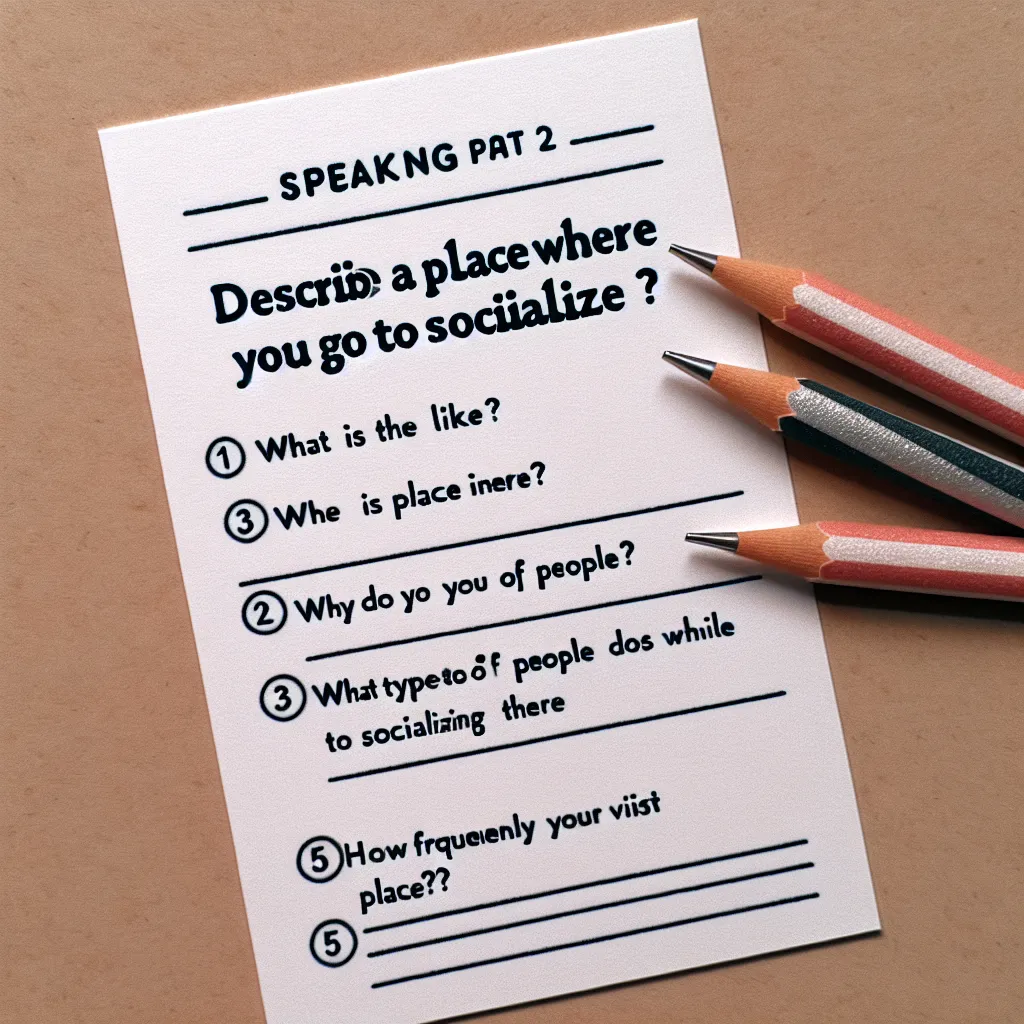As an experienced IELTS examiner, I’ve seen countless candidates struggle with the speaking section, particularly when asked to describe a place where they socialize. This topic is a common one in IELTS speaking tests and is likely to remain so in the future. In this comprehensive guide, we’ll break down how to excel in this topic across all parts of the IELTS speaking test.
Nội dung bài viết
Part 1: Introduction and Interview
In this section, the examiner may ask you some general questions about socializing. Here are some common questions you might encounter:
- Do you enjoy socializing with others?
- How often do you go out to socialize?
- Where do you usually meet your friends?
- What activities do you like to do when socializing?
Let’s look at a sample answer for the third question:
Examiner: Where do you usually meet your friends?
Sample Answer (Band 7-8):
I typically meet up with my friends at a cozy café in the city center. It’s a charming little place with comfortable seating and a relaxed atmosphere, which makes it ideal for catching up and having long conversations. The café also serves delicious pastries and a wide variety of beverages, so we can enjoy some treats while we chat.
Key phrases that can help you score higher:
- Meet up with: A natural way to describe meeting friends
- Charming: Shows a wider vocabulary than just “nice”
- Comfortable seating: Descriptive phrase
- Relaxed atmosphere: Good collocation
- Ideal for catching up: Shows understanding of idiomatic expressions
- Wide variety: Good collocation
Part 2: Long Turn
In this section, you’ll be given a cue card with a topic and some bullet points. Here’s a sample cue card related to describing a place where you socialize:
 IELTS Speaking Cue Card
IELTS Speaking Cue Card
Describe a place where you go to socialize
You should say:
- Where this place is
- How often you go there
- What you do there
- Who you usually go there with
And explain why you like socializing at this place.
Sample Answer (Band 7-8):
I’d like to talk about a vibrant coffee shop called “The Bean Scene” where I often go to socialize. It’s conveniently located in the heart of my city, just a stone’s throw away from the main shopping district.
I try to visit this place at least once a week, usually on weekends when I have more free time. It’s become somewhat of a ritual for me and my friends to meet there on Saturday afternoons.
At The Bean Scene, we typically engage in lively conversations about various topics, from our personal lives to current events. The café also hosts occasional live music performances and poetry readings, which adds an extra layer of entertainment to our social gatherings.
I usually go there with a close-knit group of friends from university, though sometimes I’ll meet work colleagues there for more casual catch-ups outside of the office environment.
The reason I particularly enjoy socializing at this place is its welcoming ambiance. The interior design is a perfect blend of modern and rustic elements, creating a cozy yet stylish atmosphere. Moreover, the staff are incredibly friendly and attentive, always ready with a smile and a chat. The diverse crowd that frequents the café also makes for interesting people-watching and sometimes leads to unexpected conversations with strangers, which I find quite enriching.
In essence, The Bean Scene provides the ideal backdrop for meaningful social interactions, combining great coffee, a pleasant environment, and the opportunity for both planned meetups and spontaneous encounters.
Examiner’s Follow-up Questions:
- Do you think the ambiance of a place affects the quality of social interactions?
- How has technology changed the way people socialize in public places?
Sample Answers (Band 8-9):
-
Absolutely, I believe the ambiance plays a crucial role in shaping social interactions. A well-designed space with appropriate lighting, comfortable seating, and a pleasant acoustic environment can significantly enhance the quality of conversations. For instance, a bustling, overly loud venue might hinder meaningful dialogue, while a cozy, intimate setting could foster deeper connections. Moreover, the overall vibe of a place can influence people’s moods and openness to engage with others, thereby directly impacting the nature and depth of social interactions.
-
Technology has undeniably revolutionized the way people socialize in public spaces. On one hand, it has facilitated easier meetups through location-sharing apps and instant messaging. However, it has also led to the phenomenon of “alone together,” where individuals are physically present but mentally absent, engrossed in their digital devices. This can detract from face-to-face interactions and the spontaneity of chance encounters. Nevertheless, technology has also enabled new forms of social engagement, such as collaborative gaming in cafés or sharing real-time experiences on social media platforms, which can enhance social bonds in unique ways.
Part 3: Two-way Discussion
In this section, the examiner will ask more abstract questions related to the topic. Here are some potential questions and sample answers:
Examiner: How have social gathering places changed over the years in your country?
Sample Answer (Band 8-9):
Over the past few decades, there’s been a significant shift in the nature of social gathering places in my country. Traditionally, people would often congregate in public squares, community centers, or local markets. These spaces were integral to community life and fostered a strong sense of local identity.
However, with urbanization and changing lifestyles, we’ve seen a proliferation of commercial social spaces like cafés, shopping malls, and themed restaurants. These places offer a more curated experience and often cater to specific demographics or interest groups. While they provide comfortable and convenient venues for socializing, some argue that they lack the spontaneity and inclusivity of traditional gathering spots.
Interestingly, there’s been a recent resurgence of interest in public spaces and community-oriented venues. Many cities are revitalizing parks and creating pedestrian-friendly zones to encourage social interaction. Additionally, co-working spaces and multi-purpose venues that blend work, leisure, and socializing are gaining popularity, reflecting the evolving needs of a more flexible, digitally-connected society.
This evolution reflects broader societal changes, including shifts in work patterns, increased mobility, and changing expectations of social experiences. While the fundamental human need for social connection remains constant, the spaces and ways in which we fulfill this need continue to adapt and diversify.
Examiner: Do you think social media has affected the way people interact in person?
Sample Answer (Band 8-9):
Social media has undoubtedly had a profound impact on in-person interactions, bringing both positive and negative changes. On the positive side, it has expanded our social networks and made it easier to maintain connections with people regardless of geographical distance. This often leads to more diverse and frequent social gatherings, as people can easily organize events or meetups through social platforms.
However, there are also concerning trends. Many people report feeling less present during face-to-face interactions due to the constant pull of digital notifications. There’s a phenomenon known as “phubbing” – snubbing someone in favor of your phone – which can negatively impact the quality of in-person conversations and relationships.
Moreover, social media has created a culture of constant comparison and curated self-presentation, which can make some people feel anxious or inadequate in real-life social situations where they can’t control their image as meticulously. This can lead to decreased confidence in face-to-face interactions and a preference for online communication.
On the flip side, social media has also enriched in-person interactions by providing shared experiences and topics for discussion. People often meet up to talk about content they’ve seen online or to participate in trends or challenges originating from social platforms.
In essence, while social media has altered the landscape of social interaction, its impact on in-person communication is complex and multifaceted. The key lies in finding a balance and being mindful of how we use these tools to enhance rather than replace real-world connections.
Key Vocabulary and Phrases for High Scores
-
Vibrant /ˈvaɪbrənt/ (adjective): Full of energy and life
Example: The vibrant atmosphere of the café made it a popular spot for socializing. -
Conveniently located (phrase): Situated in an easily accessible place
Example: The restaurant is conveniently located in the city center, making it easy for friends to meet up. -
Stone’s throw away (idiom): Very near
Example: The park is just a stone’s throw away from my house, so I often go there to meet friends. -
Engage in (phrasal verb): To take part in or participate in
Example: We often engage in lively debates at our favorite coffee shop. -
Close-knit /ˌkləʊs ˈnɪt/ (adjective): Tightly integrated, having close relationships
Example: I usually go to the club with my close-knit group of college friends. -
Ambiance /ˈæmbiəns/ (noun): The character and atmosphere of a place
Example: The cozy ambiance of the café makes it perfect for intimate conversations. -
Diverse crowd (phrase): A mix of different types of people
Example: The bar attracts a diverse crowd, which makes for interesting social interactions. -
Enriching /ɪnˈrɪtʃɪŋ/ (adjective): Improving or enhancing quality or value
Example: Meeting new people at social events can be an enriching experience.
Tips from an IELTS Examiner
- Practice describing places in detail, focusing on atmosphere, activities, and reasons for liking them.
- Use a variety of vocabulary related to socializing and places. Don’t just stick to basic words like “nice” or “good”.
- Structure your answers clearly, especially in Part 2. Use linking words to connect your ideas.
- In Part 3, try to give balanced answers that consider different perspectives.
- Use personal examples to illustrate your points, but don’t go off-topic.
- Listen carefully to the questions and make sure you’re answering what’s being asked.
- Speak at a natural pace and don’t worry if you need a moment to think – it’s better to pause briefly than to rush and make mistakes.
Remember, the key to success in the IELTS Speaking test is practice and confidence. Use these tips and examples to guide your preparation, and you’ll be well on your way to achieving a high score.
For more tips on acing the IELTS Speaking test, check out our guide on how to describe a time when you attended a social event. You might also find it helpful to read about describing a place where you feel most comfortable, as this can often overlap with places where you socialize.


